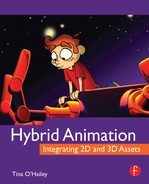0%
20Chapters
0-1Hours read
0kTotal Words
Book Description
Artist imaginations continue to grow and stretch the boundaries of traditional animation. Successful animators adept and highly skilled in traditional animation mediums are branching out beyond traditional animation workflows and will often use multiple forms of animation in a single project. With the knowledge of 3D and 2D assets and the integration of multiple animation mediums into a single project, animators have a wealth of creative resources available for a project that is not limited to a specific animation medium, software package or workflow processs.Enhance a poignant scene by choosing to animate the scenic background in 2D while the main character is brought to life with 3D techniques. Balance the budget demands of a project by choosing to integrate a 2D or 3D asset to save time and expense. Choose which medium Hybrid Animation, learn the systematic development of the 2D and 3D assets and the issues surrounding choices made during the creative process.
